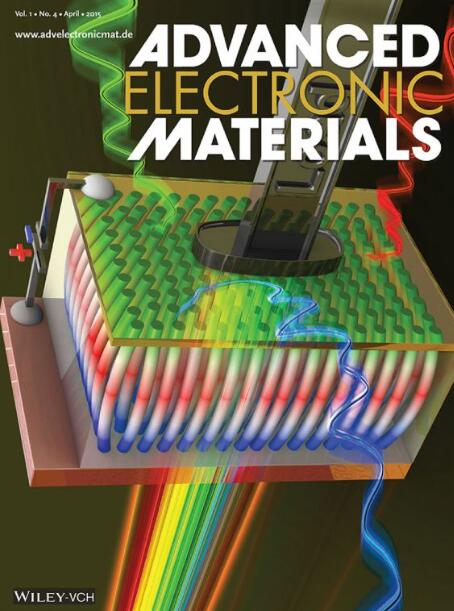Electrically-Driven Metal-Insulator Transitions Emerging from Localizing Current Density and Temperature
IF 5.3
2区 材料科学
Q2 MATERIALS SCIENCE, MULTIDISCIPLINARY
引用次数: 0
Abstract
Negative differential resistance (NDR) is a key electronic response enabling two-terminal artificial neurons that can be achieved through different physical phenomena, including phase-homogeneous current density and temperature (electro-thermal) localizations and spatially-localized metal-insulator phase transitions (MITs). These two effects have been observed to occur sequentially in select electrically-biased transition metal oxides. However, it is unknown why and under what conditions localizing behaviors precede MITs, particularly as a function of device length scale. To this end, the interplay between phase-homogeneous electro-thermal localizations and MITs is investigated in a 3D multiphysics simulation of a lateral thin film device, using the material properties of the prototype MIT material VO2. These findings demonstrate that the MIT is nucleated through dynamically localizing current density and temperature. A critical device width (≈0.7 µm in this study) is identified, below which both the electrically-induced electro-thermal and phase inhomogeneities cease to appear. It is demonstrated that the formation of spatial inhomogeneities directly relates to device dimensions, and demonstrate the decoupling of NDR from the MIT through device scaling relationships. These results provide insight into the material phenomena underlying the material's electrical responses, clarifying conditions under which spatial inhomogeneities form in electrically-biased MIT materials.

电流密度和温度局域化导致的电驱动金属绝缘体跃迁
负差分电阻(NDR)是实现双端人工神经元的一种关键电子响应,它可以通过不同的物理现象实现,包括相位均匀的电流密度和温度(电热)定位以及空间定位的金属-绝缘体相变(MIT)。据观察,这两种效应在某些电偏压过渡金属氧化物中会相继出现。然而,人们还不知道为什么以及在什么条件下局部化行为会先于 MITs 出现,特别是作为器件长度尺度的函数。为此,我们利用原型 MIT 材料 VO2 的材料特性,在横向薄膜器件的三维多物理场模拟中研究了相均电热定位与 MIT 之间的相互作用。这些研究结果表明,MIT 是通过动态局部电流密度和温度成核的。临界器件宽度(在本研究中≈0.7 微米)已经确定,在此宽度以下,电引起的电热不均匀性和相位不均匀性都不再出现。研究表明,空间不均匀性的形成与器件尺寸直接相关,并通过器件缩放关系证明了 NDR 与 MIT 的解耦。这些结果让我们深入了解了材料电响应背后的材料现象,明确了电偏压麻省理工材料形成空间不均匀性的条件。
本文章由计算机程序翻译,如有差异,请以英文原文为准。
求助全文
约1分钟内获得全文
求助全文
来源期刊

Advanced Electronic Materials
NANOSCIENCE & NANOTECHNOLOGYMATERIALS SCIE-MATERIALS SCIENCE, MULTIDISCIPLINARY
CiteScore
11.00
自引率
3.20%
发文量
433
期刊介绍:
Advanced Electronic Materials is an interdisciplinary forum for peer-reviewed, high-quality, high-impact research in the fields of materials science, physics, and engineering of electronic and magnetic materials. It includes research on physics and physical properties of electronic and magnetic materials, spintronics, electronics, device physics and engineering, micro- and nano-electromechanical systems, and organic electronics, in addition to fundamental research.
 求助内容:
求助内容: 应助结果提醒方式:
应助结果提醒方式:


